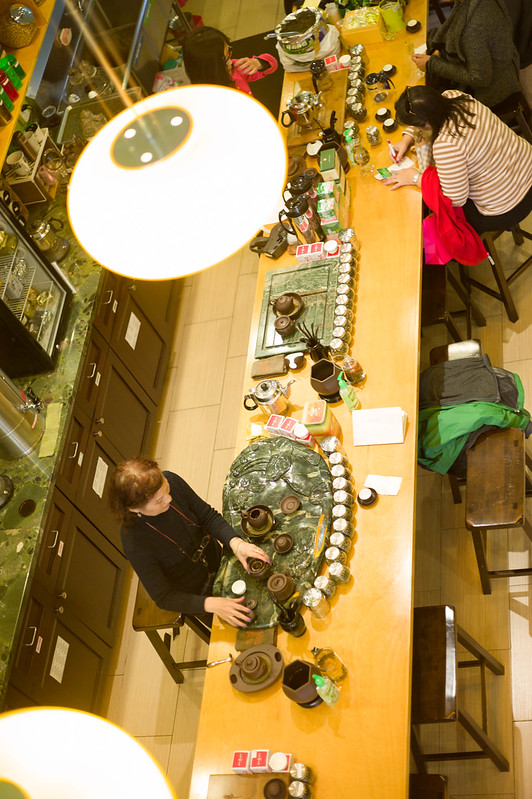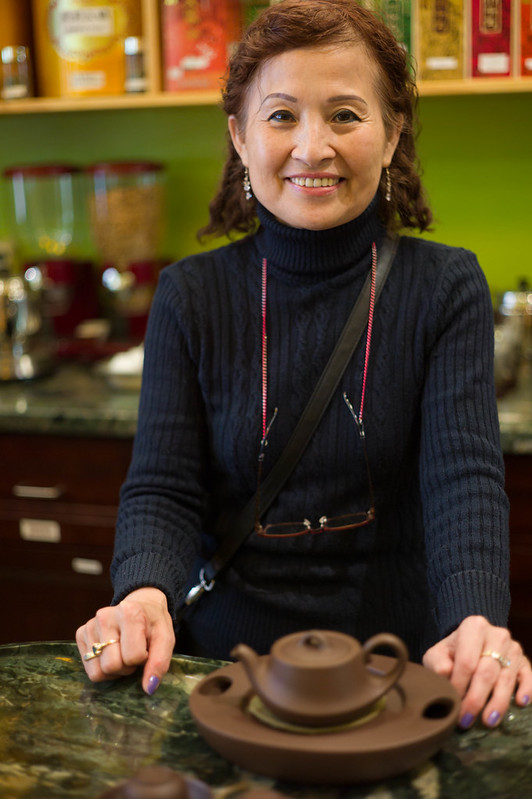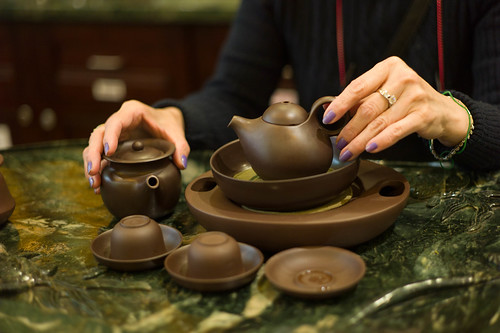One of my friends recently got me into trying some fine and exotic teas (thanks, Bill!). While I was in San Francisco, I decided to do something special, and stopped into the Ten Ren's Tea shop in Chinatown. Yes, I know it's a big potential tourist trap, but I found it to be a very enjoyable experience. And yes, they did succeed in selling me some fine teas.
Ten Ren's, San Francisco, by Reed A. George
Leica M9, Leica 50mm Summicron f2, v.3 Lens
iso 400, f2.4, 1/4000 sec.
Here's what the tasting room looks like from above. A selection of teas is stored in glass containers (at the front of the serving stone) for you to see and smell the differences between different types of leaves. Notice the lady at top right, taking notes.
Tea Room From Above, by Reed A. George
Leica M9, Leica 50mm Summicron f2, v.3 Lens
iso 640, f2, 1/60 sec.
This is Mary, the very classy and friendly lady who served me my selections.
Mary, by Reed A. George
Leica M9, Leica 50mm Summicron f2, v.3 Lens
iso 640, f2.8, 1/60 sec.
I told Mary that I was interested mainly in two types of tea - green and Pu-erh, which I'd heard about but never tasted. Mary served me two different greens - the first from the most famous green tea fields in Taiwan (Formosa), the second a Dragon Well variety. I preferred the Dragon Well, as it tasted a little less "earthy" (also read, "grassy") to me.
Next, we moved on to Pu-erh, which is fermented tea. Unlike other types of tea, where the leaves should be kept as fresh as possible, and where storing 1-2 years in proper (cool, dark) conditions is a maximum, Pu-erh gets better with age. Mary had Pu-erh teas from 10-60 years old. I believe the one I tried was 30 years old. The brewing process is different from green teas. First, you use boiling water (green teas should be brewed at a lower temperature, around 85 degrees C), you also throw away the first brew, which is essentially a rinse of boiling water. Finally, you brew it approximately two times longer than greens.
The most important thing I learned from Mary is this - you can reuse your tea leaves many times throughout a single day. For greens, 4-5 uses is normal. For Pu-erhs, it can be 15 times or more. That's an important tip. I also learned that as you reuse them through the day, the caffeine content is reduced with each brewing. You can further reduce caffeine by shortening the brewing time. So, by the afternoon when you've brewed several times, your tea is essentially nearly decaffeinated. I like how using the tea throughout the day automatically lessens the caffeine, so you can finish up in the evening with very low amounts of it.
So, I must say that I thoroughly enjoyed the experience. I got an education along with experiencing some very nice, high end teas. Did it cost me some money in the end? Yes, I bought two teas and some ginseng powder, which Mary suggested adding to evening teas to help you sleep. But, I get to continue to enjoy those teas for months to come (maybe years for the Pu-erh tea I bought). Well worth the expense.
Tea Education, by Reed A. George
Leica M9, Leica 50mm Summicron f2, v.3 Lens
iso 640, f2.4, 1/60 sec.
DMC-365.blogspot.com




No comments:
Post a Comment